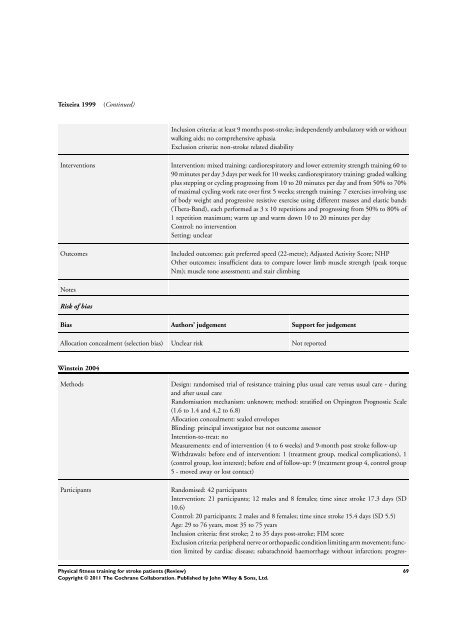Physical fitness training for stroke patients (Review) - Update Software
Physical fitness training for stroke patients (Review) - Update Software
Physical fitness training for stroke patients (Review) - Update Software
Create successful ePaper yourself
Turn your PDF publications into a flip-book with our unique Google optimized e-Paper software.
Teixeira 1999 (Continued)<br />
Inclusion criteria: at least 9 months post-<strong>stroke</strong>; independently ambulatory with or without<br />
walking aids; no comprehensive aphasia<br />
Exclusion criteria: non-<strong>stroke</strong> related disability<br />
Interventions Intervention: mixed <strong>training</strong>: cardiorespiratory and lower extremity strength <strong>training</strong> 60 to<br />
90 minutes per day 3 days per week <strong>for</strong> 10 weeks; cardiorespiratory <strong>training</strong>: graded walking<br />
plus stepping or cycling progressing from 10 to 20 minutes per day and from 50% to 70%<br />
of maximal cycling work rate over first 5 weeks; strength <strong>training</strong>: 7 exercises involving use<br />
of body weight and progressive resistive exercise using different masses and elastic bands<br />
(Thera-Band), each per<strong>for</strong>med as 3 x 10 repetitions and progressing from 50% to 80% of<br />
1 repetition maximum; warm up and warm down 10 to 20 minutes per day<br />
Control: no intervention<br />
Setting: unclear<br />
Outcomes Included outcomes: gait preferred speed (22-metre); Adjusted Activity Score; NHP<br />
Other outcomes: insufficient data to compare lower limb muscle strength (peak torque<br />
Nm); muscle tone assessment; and stair climbing<br />
Notes<br />
Risk of bias<br />
Bias Authors’ judgement Support <strong>for</strong> judgement<br />
Allocation concealment (selection bias) Unclear risk Not reported<br />
Winstein 2004<br />
Methods Design: randomised trial of resistance <strong>training</strong> plus usual care versus usual care - during<br />
and after usual care<br />
Randomisation mechanism: unknown; method: stratified on Orpington Prognostic Scale<br />
(1.6 to 1.4 and 4.2 to 6.8)<br />
Allocation concealment: sealed envelopes<br />
Blinding: principal investigator but not outcome assessor<br />
Intention-to-treat: no<br />
Measurements: end of intervention (4 to 6 weeks) and 9-month post <strong>stroke</strong> follow-up<br />
Withdrawals: be<strong>for</strong>e end of intervention: 1 (treatment group, medical complications), 1<br />
(control group, lost interest); be<strong>for</strong>e end of follow-up: 9 (treatment group 4, control group<br />
5 - moved away or lost contact)<br />
Participants Randomised: 42 participants<br />
Intervention: 21 participants; 12 males and 8 females; time since <strong>stroke</strong> 17.3 days (SD<br />
10.6)<br />
Control: 20 participants; 2 males and 8 females; time since <strong>stroke</strong> 15.4 days (SD 5.5)<br />
Age: 29 to 76 years, most 35 to 75 years<br />
Inclusion criteria: first <strong>stroke</strong>; 2 to 35 days post-<strong>stroke</strong>; FIM score<br />
Exclusion criteria: peripheral nerve or orthopaedic condition limiting arm movement; function<br />
limited by cardiac disease; subarachnoid haemorrhage without infarction; progres-<br />
<strong>Physical</strong> <strong>fitness</strong> <strong>training</strong> <strong>for</strong> <strong>stroke</strong> <strong>patients</strong> (<strong>Review</strong>)<br />
Copyright © 2011 The Cochrane Collaboration. Published by John Wiley & Sons, Ltd.<br />
69












